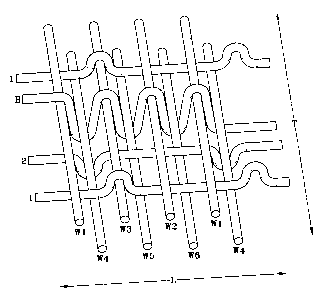Une partie des informations de ce site Web a été fournie par des sources externes. Le gouvernement du Canada n'assume aucune responsabilité concernant la précision, l'actualité ou la fiabilité des informations fournies par les sources externes. Les utilisateurs qui désirent employer cette information devraient consulter directement la source des informations. Le contenu fourni par les sources externes n'est pas assujetti aux exigences sur les langues officielles, la protection des renseignements personnels et l'accessibilité.
L'apparition de différences dans le texte et l'image des Revendications et de l'Abrégé dépend du moment auquel le document est publié. Les textes des Revendications et de l'Abrégé sont affichés :
| (12) Demande de brevet: | (11) CA 2758418 |
|---|---|
| (54) Titre français: | TISSU CROISE DOUBLE COUCHE POUR UTILISATION DANS LES COURROIES DE TRANSPORTEUR |
| (54) Titre anglais: | DUAL LAYER TWILL FABRIC FOR CONVERYOR BELT APPLICATIONS |
| Statut: | Réputée abandonnée et au-delà du délai pour le rétablissement - en attente de la réponse à l’avis de communication rejetée |
| (51) Classification internationale des brevets (CIB): |
|
|---|---|
| (72) Inventeurs : |
|
| (73) Titulaires : |
|
| (71) Demandeurs : |
|
| (74) Agent: | SMART & BIGGAR LP |
| (74) Co-agent: | |
| (45) Délivré: | |
| (22) Date de dépôt: | 2011-11-16 |
| (41) Mise à la disponibilité du public: | 2012-05-18 |
| Licence disponible: | S.O. |
| Cédé au domaine public: | S.O. |
| (25) Langue des documents déposés: | Anglais |
| Traité de coopération en matière de brevets (PCT): | Non |
|---|
| (30) Données de priorité de la demande: | ||||||
|---|---|---|---|---|---|---|
|
A composite fabric for use in a conveyor belt has a first weft sheet of
individual weft yarns, a second weft sheet of individual weft yarns, a top
warp
yarn, a bottom warp yarn, and a binder yarn. The first and second weft sheet
yarns have an outer side and an opposing inner side, wherein their inner sides
are adjacent to each other. The top warp yarn extends at least in part between
the first and second weft sheet, and at least in part is woven around at least
one
first weft sheet yarn outer side. The bottom warp yarn extends at least in
part
between the first and said second weft sheet, and at least in part is woven
around at least one second weft sheet yarn outer side. The top warp yarn does
not weave around any second weft sheet yarns, and the bottom warp yarn does
not weave around any first weft sheet yarns. The binder yarn weaves
alternately
around a first weft sheet yarn outer side, and a second weft sheet yarn outer
side.
Note : Les revendications sont présentées dans la langue officielle dans laquelle elles ont été soumises.
Note : Les descriptions sont présentées dans la langue officielle dans laquelle elles ont été soumises.

2024-08-01 : Dans le cadre de la transition vers les Brevets de nouvelle génération (BNG), la base de données sur les brevets canadiens (BDBC) contient désormais un Historique d'événement plus détaillé, qui reproduit le Journal des événements de notre nouvelle solution interne.
Veuillez noter que les événements débutant par « Inactive : » se réfèrent à des événements qui ne sont plus utilisés dans notre nouvelle solution interne.
Pour une meilleure compréhension de l'état de la demande ou brevet qui figure sur cette page, la rubrique Mise en garde , et les descriptions de Brevet , Historique d'événement , Taxes périodiques et Historique des paiements devraient être consultées.
| Description | Date |
|---|---|
| Le délai pour l'annulation est expiré | 2015-11-17 |
| Demande non rétablie avant l'échéance | 2015-11-17 |
| Réputée abandonnée - omission de répondre à un avis sur les taxes pour le maintien en état | 2014-11-17 |
| Demande publiée (accessible au public) | 2012-05-18 |
| Inactive : Page couverture publiée | 2012-05-17 |
| Lettre envoyée | 2012-02-28 |
| Lettre envoyée | 2012-02-28 |
| Inactive : CIB attribuée | 2012-02-06 |
| Inactive : Réponse à l'art.37 Règles - Non-PCT | 2012-02-03 |
| Inactive : Transfert individuel | 2012-02-03 |
| Inactive : CIB en 1re position | 2012-01-31 |
| Inactive : CIB attribuée | 2012-01-31 |
| Inactive : CIB attribuée | 2012-01-31 |
| Demande reçue - nationale ordinaire | 2011-11-30 |
| Inactive : Certificat de dépôt - Sans RE (Anglais) | 2011-11-30 |
| Date d'abandonnement | Raison | Date de rétablissement |
|---|---|---|
| 2014-11-17 |
Le dernier paiement a été reçu le 2013-10-21
Avis : Si le paiement en totalité n'a pas été reçu au plus tard à la date indiquée, une taxe supplémentaire peut être imposée, soit une des taxes suivantes :
Les taxes sur les brevets sont ajustées au 1er janvier de chaque année. Les montants ci-dessus sont les montants actuels s'ils sont reçus au plus tard le 31 décembre de l'année en cours.
Veuillez vous référer à la page web des
taxes sur les brevets
de l'OPIC pour voir tous les montants actuels des taxes.
| Type de taxes | Anniversaire | Échéance | Date payée |
|---|---|---|---|
| Taxe pour le dépôt - générale | 2011-11-16 | ||
| Enregistrement d'un document | 2012-02-03 | ||
| TM (demande, 2e anniv.) - générale | 02 | 2013-11-18 | 2013-10-21 |
Les titulaires actuels et antérieures au dossier sont affichés en ordre alphabétique.
| Titulaires actuels au dossier |
|---|
| VEYANCE TECHNOLOGIES, INC. |
| Titulaires antérieures au dossier |
|---|
| WESLEY JAMES BILLUPS |